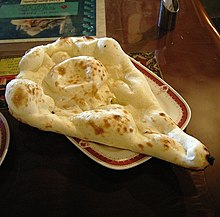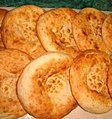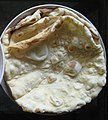Naan
 | |
| Alternative names | Nan, Noon, Paan, Faan |
|---|---|
| Region or state | South Asia, Afghanistan, Indonesia, Malaysia, Myanmar, and the Caribbean |
| Main ingredients | Flour, yeast, salt, water |
| |
Naan (Persian: نان, romanized: nān, Urdu: نان, Punjabi: نان, Kurdish: نان, Pashto: ډوډی, Uyghur: نان, Hindi: नान, Bengali: নান) is a leavened, oven-baked (usually using a tandoor) or tawa-fried flatbread, which is found in the cuisines mainly of Afghanistan, South Asia, Central Asia, Indonesia, Malaysia, Myanmar, and the Caribbean.
Etymology

The term "naan" comes from Persian nân (Persian: نان), a generic word for any kind of bread. This word was borrowed into a range of languages in the Indian subcontinent and Central Asia, where it came to refer to a specific type of bread. The term then spread around the globe along with the style of bread itself.
The earliest known English use of the term occurs in an 1803 travelogue written by William Tooke. While Tooke and other early sources spell it "nan", the spelling naan has become standard since the 1970s.
Varieties
South Asia
The most familiar and readily available varieties of naan in Western countries are those from South Asia. Naan spread to Indian subcontinent during Islamic Delhi Sultanate period. The earliest mention of naan in the region comes from the memoirs of Indo-Persian Sufi poet Amir Khusrau living in India during the 1300s AD. Amir Khusrau mentions two kinds of naan eaten by Muslim nobles; Naan-e-Tunuk and Naan-e-Tanuri. Naan-e-Tunuk was a light or thin bread, while Naan-e-Tanuri was a heavy bread and was baked in the tandoor. The Ain-i-Akbari, a written record of the third Mughal emperor’s reign, also mentions naan and it was eaten with kebabs or kheema (spiced minced meat) in it. By the 1700s naan had reached the masses in Mughal cultural centers in South Asia.
Indonesia
In Indonesia, naan is popular in Indian Indonesian and Arab Indonesian communities as well as in Malay, Acehnese and Minangkabau communities–with other variants of roti like roti canai. This dish is usually locally known as roti naan or roti nan and cooked using Indonesian spices, such as garlic with a local taste.
Myanmar
Naan bya (Burmese: နံပြား) in Myanmar is traditionally served at teahouses with tea or coffee as a breakfast item. It is round, soft, and blistered, often buttered, or with creamy pè byouk (boiled chickpeas) cooked with onions spread on top, or dipped with Burmese curry.
| External image | |
|---|---|
|
|
China
The Jingzhou style of guokui, a flatbread prepared inside a cylindrical charcoal oven much like a tandoor, has been described as "Chinese naan". It is also an integral part of Uyghur cuisine and is known in Chinese as 馕 (náng).
Japan
After being promoted by Kandagawa Sekizai Shoukou in 1968, which is now the sole domestic manufacturer of tandoors, naan is now widely available in Indian-style curry restaurants in Japan, where naan is typically free-flow. Some restaurants bake ingredients such as cheese, garlic, onions, and potatoes into the naan, or cover it with toppings like a pizza.
Elsewhere
Naan pizza is a type of pizza where naan is used as the crust instead of the traditional pizza dough. Chefs such as Nigella Lawson, and supermarkets such as Wegmans offer recipes for people to make their own naan pizza at home, though it is certainly not traditional.
Gallery
-
 Nan in Afghanistan
Nan in Afghanistan -
 Nan in Kabul, Afghanistan
Nan in Kabul, Afghanistan -
 Nan in Mazar-e Sharif, Afghanistan
Nan in Mazar-e Sharif, Afghanistan -

-

-

-
 Nan in Iran
Nan in Iran -
Nân-e barbari in Iran
-
 Nân-e sangak in Iran
Nân-e sangak in Iran -
 Nân-e tâftun in Iran
Nân-e tâftun in Iran -
 Butter garlic naan
Butter garlic naan -
 Paneer naan
Paneer naan -
 Burmese nan bya
Burmese nan bya












